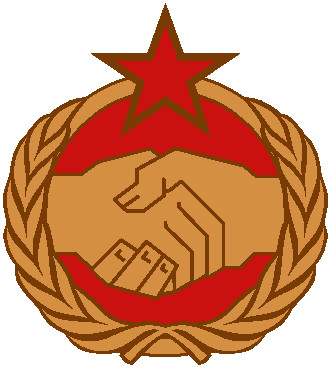Subsequent visual arts bolseiros included Pais Ernesto Shikani (1934–2010) and Samate Machava (1939–2012), who in 1982 both undertook six‐month fine art courses in Moscow. Dias Machlate (b. 1958) followed, spending six years studying art in Dresden from 1983, along with another Mozambican artist, Francisco Maria Conde (b. 1957), and seven Ethiopian students.19
Pedro ‘Dito’ Jeremias Tembe (b. 1960) also studied visual art in the German Democratic Republic (GDR), arriving with 150 other Madgermane labourers in 1985 to work at the Lederwaren Suede Factory in Schwerin, Mecklenburg. There, he negotiated with the Mozambique Embassy to attend a three‐year visual arts course at the Russia and Germany Friendship House in Schwerin, from 1987 to 1989.20
Following their studies at ENAV, Pompílio ‘Gemuce’ Hilário (b. 1963) and Bento Mukeswane (1965–99) were sent with two others to study art in Kiev in 1985. After a year of language tuition, Gemuce completed a BA in Fine Art at the Institute of Fine Arts of Kiev, and then an MFA at the Ukrainian Academy of Fine Arts, returning to Mozambique in 1993.21 The final Mozambican art students to take up bursaries through socialist channels were Carmen Maria Muianga (b. 1974) and Marcos Bonifácio Muthewuye (b. 1972).
Both students at ENAV, they were selected for bursaries by the school’s director Estela Teixeira, and travelled to Cuba to study at the Instituto Superior de Arte in Havana, from 1991 until 1995.22 Carmen specialized in printmaking, and studied with artist Belkis Ayón (1967–99) and printmaker Agustín Bejerano (b. 1964). Muthewuye also recalled two dance students from Mozambique (Augusto Coveillas and Maria Elena Pinto) and two music students (Jonathan Zamba and Amelia Matsinha), as amongst those who studied in Havana.23
Cuban and Soviet policies of internationalist solidarity with leftist and anti‐colonial movements in Africa also enabled artists from other parts of the continent to secure training within these programmes. Many Angolan artists studied in Cuba, for example, including Jorge Gumbe (b. 1959), who graduated in Painting and Design at the Escola Nacional de Arte in Havana in 1989, and art historian Adriano Mixinge (b. 1968), who studied on the island for fourteen years, ultimately graduating in Art History at the University of Havana in 1993.24
Ethiopia’s diplomatic links with Russia predated the October Revolution, and art students had travelled to Moscow from the 1950s. Geta Mekonnen records that, between 1961 and 1974, fourteen out of 119 students enrolled at Addis Ababa School of Fine Arts were sent to study in Eastern bloc countries.25 These numbers accelerated rapidly under the Derg’s Marxist‐Leninist government (1974–87). Bekele Mekonnen, Director of the Art School in Addis, studied at the Surikov Academy in Moscow for six years, beginning in 1987.
[…]
[A]lthough many Mozambican artists remember the socialist moment in ambiguous terms, the Tashkent bolseiros shared an enduring commitment to ideals of solidarity and equality. While the end of socialism might have allowed for more diverse forms of artistic expression, it also fostered increased power inequalities.
Raimundo fondly recalled the utopian [sic] promises of Soviet socialism, and in his 2008–9 series Kuwoca addressed the theme of solidarity, his finely worked watercolours depicting intimate moments of community: a woman helping a bereaved friend with her laundry (plate 11), a group of fisherman carrying a boat (plate 12). ‘I’m talking of socialization and cooperation’, he recalled, ‘how neighbours help each other, and look after each other’. Cejuma also valued the egalitarianism of the socialist moment:
I liked the political system of communism […] it gave more value to life […] People would join together to make a social life, separated from consumption. Your salary would cover all your expenses — clothes, food, water, gas to cook anything, a house to live in, electricity, even for those people who lived right out in the remote forests — everybody had those things. It was marvellous […] In a capitalist country, they don’t want to know. It’s a fight of power — win if you can — while I have my big sack of money, that person over there who has nothing to eat can die. It’s not just.84
(Emphasis added.)
I should warn you that since a noncommunist clearly wrote this, typical antisocialist clichés abound. For example:
The strictest Marxist‐Leninist approach held that nations, like classes, would dissolve with the onset of communism,50 but the idea of the nation remained embedded in Soviet thought and the very notion of a homogenous Uzbek identity was in fact Soviet in origin. […] In many respects the Soviet Union’s brand of colonialism was significantly different from European models, […] the red Soviet flag inaugurates a utopian ‘new life’ in Mozambique,
If you can bear these flaws, though, this is an otherwise fine reading.
Honestly, this isn’t that bad; hell, I’ve seen a lot worse in academic articles:
The strictest Marxist‐Leninist approach held that nations, like classes, would dissolve with the onset of communism,50 but the idea of the nation remained embedded in Soviet thought and the very notion of a homogenous Uzbek identity was in fact Soviet in origin. […] In many respects the Soviet Union’s brand of colonialism was significantly different from European models, […] the red Soviet flag inaugurates a utopian ‘new life’ in Mozambique,
Glad that I know someone other than myself that likes to go through Google Scholar or whatever in order to find scholarly articles (I go to LibGen next and then save the PDF documents to my MEGA).
JSTOR is a godsend… if it weren’t so expensive.



